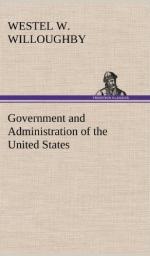1. In 1793 the case of Chisolm vs. Georgia came before this court. Chisolm, a citizen of North Carolina, sued the State of Georgia for a sum of money, and under the second section of Article III of the Constitution, which says that the judicial power of the United States shall extend to disputes between a State and citizens of another State, the court gave judgment in his favor. This decision that a State government could be sued against its will created so much dissatisfaction that the Eleventh Amendment was adopted, which says, “the judicial power of the United States shall not be construed to extend to any suit in law or equity commenced or prosecuted against one of the United States by citizens of another State, or by citizens or subjects of any foreign State.” The effect of this amendment has been to enable a State to repudiate its just debts.
2. In 1819 was decided the very important case of McCulloch vs. Maryland. The United States had established a national bank, which was objectionable to many of the States. Maryland attempted to destroy the bank by levying a very high tax upon a branch bank within the State. The question as to her right to do this was brought before the Supreme Court. To have allowed Maryland this right would have been to give to a State Government the power to oppose and render useless an institution created by the Federal Government. The court sustained the Federal power, and it was declared unconstitutional for any State to pass laws opposing the operation of any Federal statute.
3. In the case of Dartmouth College vs. New Hampshire was declared the unconstitutionally of a state law which impaired the obligation of contracts.
4. A very important case decided by Chief Justice Taney was that of Dred Scott vs. Sandford in 1857. Dred Scott, a negro slave in Missouri, had been carried into the Territory of Minnesota, where, by the Missouri Compromise of 1820, slavery did not exist. Upon being carried back into Missouri by his master, Scott claimed his freedom upon the ground that he had been voluntarily carried into a Territory where slavery was not allowed. The Supreme Court in its decision declared that Congress had never had the power to pass any law which would forbid slave-owners settling in Territories and still retaining control of their slaves. The whole country was at this time in great excitement in regard to the question whether or not, in the organization of the Territories of Kansas and Nebraska into States, slavery should be prohibited, and this decision, whereby the Missouri Compromise Act was practically annulled, and which pointed directly forward to an establishment of slavery in the new Territories, raised public excitement to a fever heat. It was in this decision that the statement was made that at the time of the formation of the Constitution the general opinion had been that the colored man had no rights which the white man was bound to respect. As a direct result of this case a more determined stand was taken at the North against slavery; the Anti-Slavery Republican party was strengthened, and their candidate for President, Abraham Lincoln, elected in 1861, and the catastrophe of civil war precipitated.




